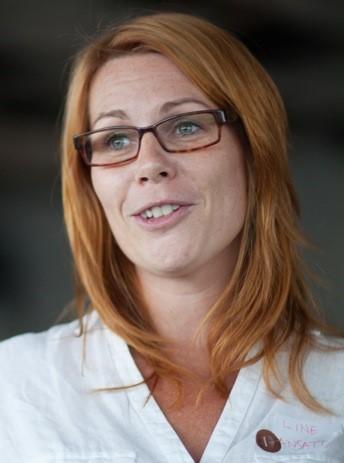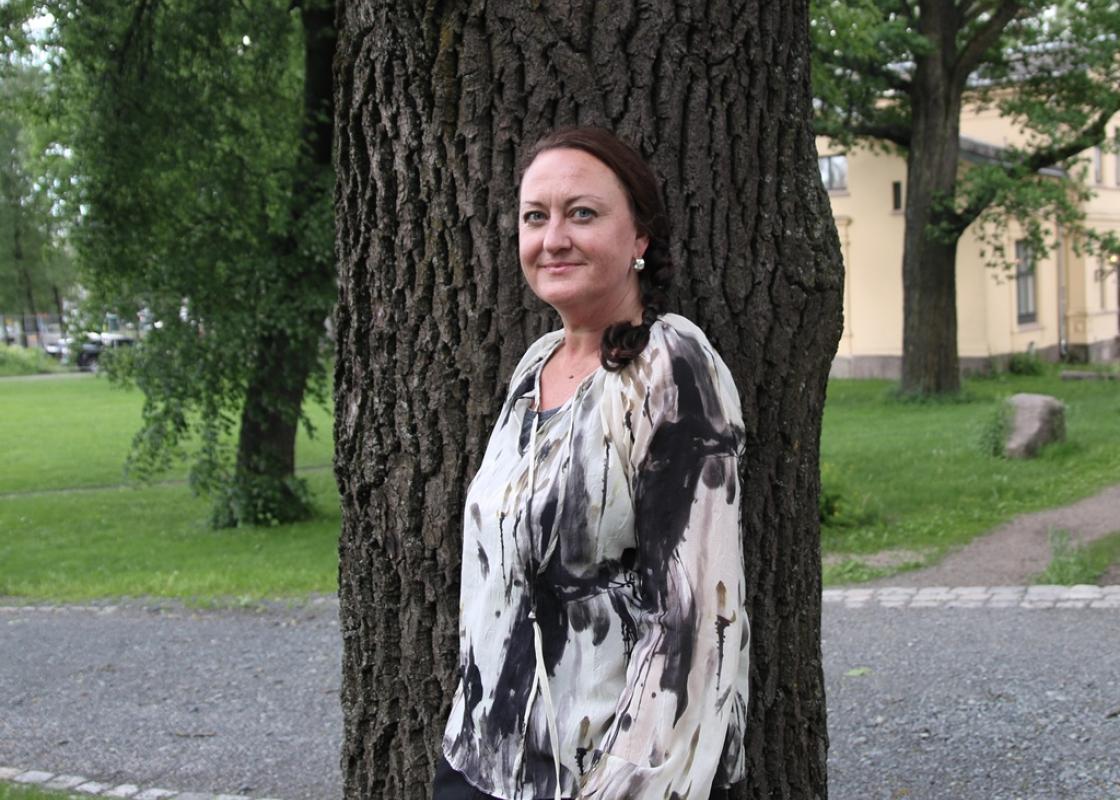Three women are walking on high heels along the catwalk. The next picture shows a man in an overall coat looking into a microscope. Thereafter, the pictures change between the women’s shoes, nail polish, red lips, and a steaming test tube in a laboratory. This is clearly a depiction of the preparation of cosmetics. At the end of the film, the women replace their pink sunglasses with safety goggles.
The message is as clear as day: Making cosmetics is chemistry and hard science, and therefore also suitable for girls.
“But as one of the girls in my study said: ‘I’m not studying chemistry in order to work in a L’Oréal laboratory.”
Marianne Løken’s PhD thesis is about girls who choose to study the hard sciences and why. According to her, many of the attempts to recruit girls to the hard sciences have contributed to a strengthening of gender stereotypes rather than breaking them down. And the campaign film Science is a girl thing, which is the result of an EU collaboration in order to make girls choose the hard sciences is one of the worst examples she can think of. It has also received harsh criticism.
Oversimplified picture
“I have been interested in gender for many years, and I have worked a lot to evoke children’s interest in the hard sciences through the Research Council of Norway’s program Nysgjerrigper (‘nosy parker’) among other things,” she says.
“Much of what I’ve seen showed a gender segregated picture that did not always correspond to my experiences from my encounters with young people. On the contrary, it was my experience that girls were equally interested in the hard sciences as boys, and that they absolutely could imagine a possible career as researchers.”
I wanted to look at what they choose and why.
Some recruitment campaigns informed by research on choice and participation in the hard sciences take as a starting point that women comprise a homogenous group and that they are all interested in health, well-being, make-up and fashion.
“They approach girls with the expectation that all women either want to save the world or wander around the lab in stilettoes,” says Løken.
“The campaigns provide an oversimplified picture of research and researchers, which contributes to the cementation of negative gender stereotypes.”
According to Løken, such stereotypes are inaccurate oversimplifications, both on behalf of the group itself and on behalf of each member of the group.
“That is precisely why many of the women in my study feel alienated in their encounter with descriptions of typical girls and feminine values. The picture doesn’t fit with their own perception of who they are.”
Stories about choice
Løken’s PhD thesis is an interdisciplinary qualitative study within cultural studies, interdisciplinary gender studies, and science didactics. Between 2009 and 2012, she collected stories from seventeen young women about why they had chosen to study the hard sciences. The aim was to find explanations to their choices that had not been observed by other research in the field.
“I sought to find something that hadn’t been observed before, and to challenge the current opinion. Much previous research on the area focuses on why girls don’t choose the hard sciences. I wanted to look at what they choose and why,” Løken emphasises.
Her thesis consists of three articles. In her last article, she has analysed the girls’ stories about their choices of education by the use of perspectives from post humanist theory and neomaterialism.
“This means that I have looked at the girls’ descriptions of their own experiences with the non-human such as objects, technology and nature, and examined how these affect them and the choices they make,” says Løken.
She found that the girls explain their choices of education differently and emphasise other things than what is normally highlighted when we study young people’s choice of education in a socio-cultural perspective, that is, how friends, parents and social class affect them.
See also: Why women choose ICT
Boating adventures
“Several of the girls emphasised their surroundings’ significance in terms of the non-human and material. This could be boating adventures, boat building with grandad and the smell of tar. They described how these and other experiences such as being diagnosed with dyslexia, had contributed to the shaping of their personalities and influenced their preferences and choices,” says Løken.
“In their stories, the girls demonstrate how the material has significance for their choice of education. This may give us an opportunity to take a closer look at how the material affects choices and how such insight may be used with regard to recruitment to the hard sciences. Additionally, this insight may be used in teaching and in relation to the organisation of leisure activities.”
Several of the girls wanted to use their good grades to make money and have a good life.
According to her, it is important to realise that girls are also interested in the material aspects of their surroundings. Such interests and values are often associated with boys and masculine hobbies, whereas girls are often described as more interested in people.
“Not everybody wants to work with people. Several of the girls wanted to use their good grades to make money and have a good life,” says Løken.
No homogenous group
“What is your most important finding?”
“That none of the girls I interviewed are alike,” says Løken.
“This is perhaps banal, but the banal can sometimes be difficult to spot. This is an important insight when we want to recruit girls to the hard sciences. Approaching girls as a homogenous group may have the opposite effect of what we want to achieve.”
The girls’ stories were also very ambivalent. They reflect during the process, and their descriptions are occasionally ambiguous. Particularly when it came to the descriptions of their relation to their own gender as the unrepresented gender within their chosen discipline of study.
“Some found it difficult to be a minority, whereas others thought it was great fun. They like the attention they get. But many of the girls were negative to categorising recruitment campaigns,” says Løken.
She states that the size of the minority group in which the girls find themselves naturally has an effect on their experiences. A group of twelve girls may well be a minority in a degree programme with fifty students, but they nevertheless make up a fairly big group.
“The experience of being a minority will naturally be different if there’s a group of three girls. It becomes more obvious that you belong to the minority,” she emphasises.
According to Løken, the development of post humanist perspectives in order to study choices of education is also a significant contribution in her research.
“One research objective has been to explore whether it is possible to say something new about girls and their choices of education, and in this way challenge our already existent knowledge on this area.”
Goal to reach many
Line Berg is the project leader of the girls’ project Ada at Norwegian University of Science and Technology (NTNU). Ada’s objective is to recruit more girls to study ICT – Information and Communication Technology. According to her, their Technology Camp and the Girls’ Day are among Ada’s most important recruitment measures.

“We invite girls to visit NTNU in order for them to become acquainted with ICT and to tell them why this discipline is the future. Upon asking girls why they choose ICT, many reply that it is because they have been to the Technology Camp for girls,” she says.
“Do you agree that recruitment campaigns directed at girls may have a stigmatising effect?”
“When we invite girls to the Technology Camp, we explain why we only invite girls and that the arrangement is financed by funding intended to enhance gender equality. I am slightly worried that informing girls about the fact that these subjects attract few girls may be a deterrent factor,” says Berg.
“But I personally think that even if we lose some girls, we win more of them over. Our goal is to reach many types of girls. But we are all different, even girls, and we can never reach everybody. My impression, after having talked to participants and students, is that we manage to reach a broad audience.”
I have overheard comments such as ‘the girls here are pretty’.
“I have overheard comments such as ‘the girls here are pretty’, from girls who are visiting and encountering female students of engineering and electronics. As if girls who choose these disciplines are not vain and don’t care about how their appearance.”
“But what about girls who like the hard sciences who are not interested in fashion and make-up?”
“We don’t allude to traditional feminine values in our campaigns. First and foremost, we want the girls to come here and get acquainted with the disciplines and the students.”
“But you do have a pink website?”
“That is true, and this will soon be changed. And the visual design of our material is actually based on advice from female students. Many still think that the typical ICT student is an anti-social boy with thick glasses who spends his time playing computer games in the basement. This is not how it is, we have all different kinds of students, and it is important for us to communicate that.”
See also: Gender equality creates new school boys
Translated by Cathinka Dahl Hambro.
Marianne Løken has written her PhD thesis Skriv ditt valg! Nyskriving av historier om @typiske utdanningsvalg (‘Write your choice! New stories about @typical choices of education’) at The Faculty of Mathematics and Natural Sciences, University of Oslo. Løken works at the Section for research and internationalisation at The Norwegian Directorate for Education and Training.


